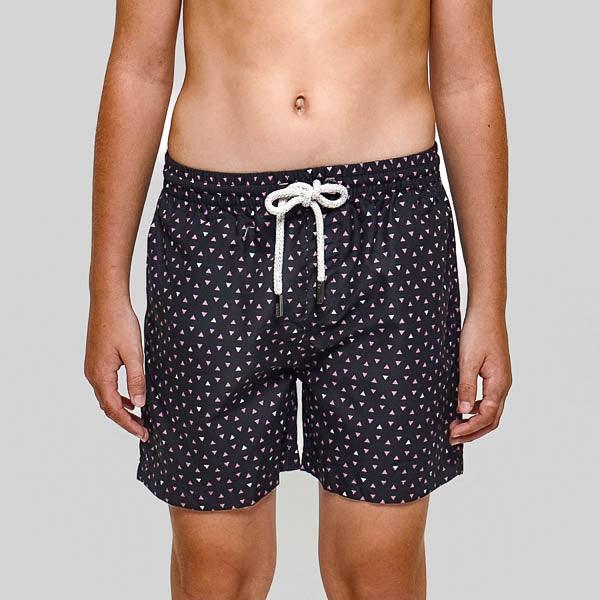Investing in high-quality swimwear for your child is essential, but it’s equally important to ensure that swimwear lasts through multiple seasons. Proper care and maintenance can significantly extend the life of boys' swimwear, keeping it looking new and ensuring it remains comfortable and effective. Here are some practical tips to help you maintain and extend the lifespan of your child's swimwear.
1. Rinse Immediately After Use
Importance of Rinsing
Chlorine from pools, salt from the ocean, and residual sunscreen can all cause damage to swimwear fabrics. Rinsing the swimwear immediately after use helps remove these substances, preventing them from breaking down the fabric over time.
How to Rinse Properly
- Cold Water Rinse: Use cold water to rinse the swimwear thoroughly. Avoid hot water as it can damage the fabric and elastic fibers.
- Gentle Hand Rinse: Gently hand rinse the swimwear rather than scrubbing it, which can cause wear and tear.
2. Use Mild Detergents
Choosing the Right Detergent
Harsh detergents and bleach can degrade swimwear fabric, causing colors to fade and elasticity to weaken. Using mild detergents designed for delicate fabrics will help maintain the integrity of the swimwear.
Washing Instructions
- Hand Wash: Whenever possible, hand wash the swimwear with a mild detergent.
- Avoid Fabric Softeners: Fabric softeners can leave residues that degrade the fabric and elastic over time.
3. Avoid Machine Washing and Drying
Risks of Machine Washing
The agitation in washing machines can stretch and damage swimwear fabrics. Additionally, the heat from dryers can weaken elastic fibers and cause shrinkage.
Best Practices
- Hand Wash: Hand wash swimwear to avoid the harsh effects of machine washing.
- Air Dry: Lay the swimwear flat to air dry in a shaded area. Avoid direct sunlight, which can fade colors and damage the fabric.
4. Handle with Care
Gentle Handling
Swimwear fabrics are delicate and can easily be damaged if not handled properly. Stretching, wringing, or pulling on the fabric can cause permanent damage.
Tips for Gentle Care
- Avoid Wringing: Instead of wringing out swimwear, gently press out excess water with a towel.
- Use a Towel: Roll the swimwear in a towel to remove excess water before laying it flat to dry.
5. Rotate Swimwear
Benefits of Rotating Swimwear
Having multiple sets of swimwear allows each piece to rest and recover its shape between uses. This helps prevent overuse and extends the life of each item.
Tips for Rotation
- Multiple Sets: Invest in at least two or three sets of swimwear for your child.
- Alternate Use: Rotate the swimwear sets regularly to ensure even wear.
6. Store Properly
Proper Storage Techniques
How you store swimwear when it's not in use can also impact its longevity. Proper storage prevents damage and helps maintain the shape and elasticity of the fabric.
Storage Tips
- Cool, Dry Place: Store swimwear in a cool, dry place away from direct sunlight.
- Avoid Tight Folding: Do not fold swimwear tightly, as this can cause creases and damage the fabric over time.
- Use a Mesh Bag: Store swimwear in a mesh bag to allow for ventilation and prevent mildew.
7. Be Cautious with Pool Surfaces
Avoid Rough Surfaces
Pool decks, rough tiles, and other abrasive surfaces can snag and damage swimwear fabric. Encourage your child to avoid sitting or sliding on these surfaces.
Protective Measures
- Towel Layer: Place a towel down for your child to sit on if they need to sit on rough surfaces.
- Awareness: Educate your child about the importance of avoiding rough surfaces to protect their swimwear.
8. Repair Minor Damages
Addressing Small Issues
Minor damages such as loose threads or small tears can be repaired to prevent further damage. Addressing these issues early can extend the life of the swimwear.
Repair Tips
- Sew Loose Threads: Use a needle and thread to secure loose threads or small tears.
- Fabric Glue: For small holes, fabric glue can be used as a temporary fix until a more permanent repair can be made.
Conclusion
By following these tips, you can significantly extend the life of your son's swimwear, ensuring it remains in good condition and comfortable to wear. Proper care and maintenance not only protect your investment but also ensure that your child can enjoy their swimwear for many seasons to come. Prioritize gentle handling, proper cleaning, and careful storage to keep swimwear looking and performing its best.
FAQs
1. Why is it important to rinse swimwear after each use?
- Rinsing removes chlorine, salt, and sunscreen residues that can damage the fabric and elastic fibers, helping to maintain the swimwear's quality and longevity.
2. Can I machine wash my son's swimwear?
- It is best to hand wash swimwear to avoid the harsh effects of machine washing, which can stretch and damage the fabric.
3. How should I store swimwear when it's not in use?
- Store swimwear in a cool, dry place away from direct sunlight. Avoid tight folding and use a mesh bag for ventilation to prevent mildew.
4. Why should I rotate my son's swimwear?
- Rotating swimwear allows each piece to rest and recover its shape between uses, preventing overuse and extending the life of the swimwear.
5. What should I do if my son's swimwear gets minor damage?
- Repair minor damages such as loose threads or small tears promptly to prevent further damage. Use a needle and thread or fabric glue for small repairs.



















